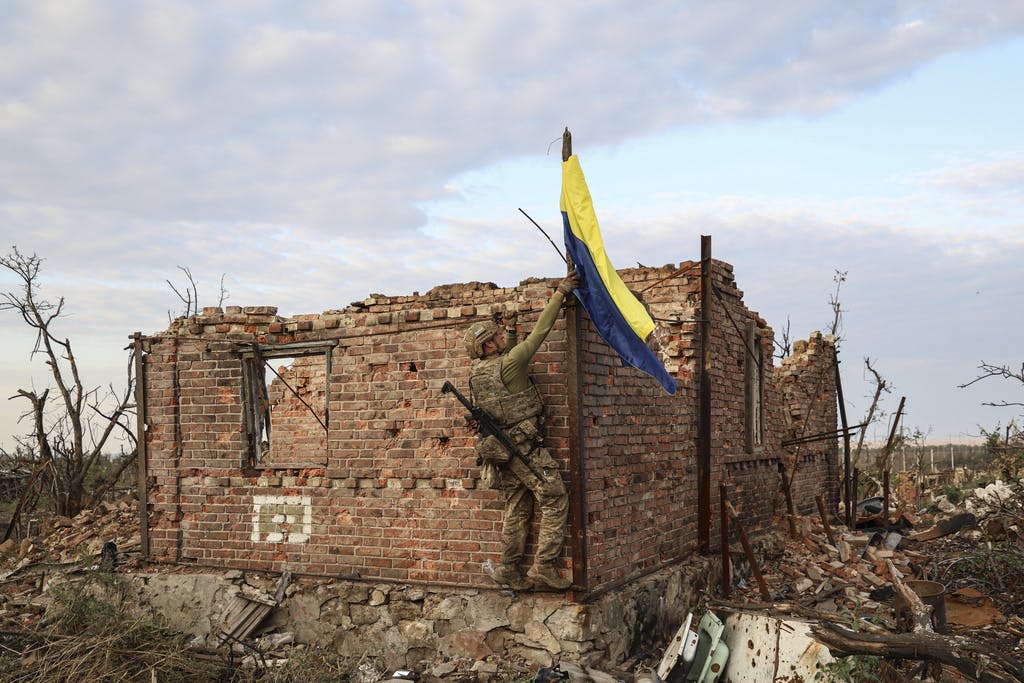Hostilities Around Kherson Risk Overshadowing Ukraine’s Incremental Gains Farther East
Attention shifts to President Zelensky’s American trip this week but there is no reprieve from battle in Ukraine’s east.

“Today I would like to particularly commend the soldiers who, step by step, are returning to Ukraine what belongs to it, namely in the area of Bakhmut,” President Zelensky said in a video address in announcing on Sunday that Ukraine had retaken the village of Klishchiivka, some six miles south of Bakhmut.
It is some welcome news in a counteroffensive that despite a string of successful drone strikes on Russian naval assets in occupied Crimea has not ousted Russian forces from much of eastern Ukraine. Yet if the world only learns an obscure village’s name after it has been retaken from an invader, despite its usefulness as a talking point, how big of an impact will it have?
Last Friday Ukraine’s military announced that it had recaptured another village south of Bakhmut, following intense battles with Russian troops. That village, Andriivaka, is even smaller than Klishchiivka, with various sources estimating it had a population of a little more than 500 before the war. Bakhmut, of course, is the Ukrainian town that is still held by Russian forces, though today it mostly lies in ruins.
The army’s Third Assault Brigade said it took Andriivka after encircling a Russian garrison stationed there during what it described as a “lightning operation” and took it out over two days. It called the successful action a breakthrough on the southern flank of Bakhmut and “key to success in all further directions.”
While Ukraine’s incremental gains are not to be denied or minimized, the long-term significance remains an open question, particularly given Russia’s hold on Mariupol and Berdyansk farther south and the increased volatility around Kherson.
Over the weekend Russian troops attacked the Kherson region 77 times, firing 334 projectiles. According to Ukraine’s governor of the region, Oleksandr Produkin, the Russians used mortars, artillery, drones, tanks, aircraft, and Grad multiple launch rocket systems in the assault. They also fired at the city of Kherson, which Ukraine recaptured from Russian forces in November 2022.
Unlike that city, the region that surrounds Kherson is still nominally under Russian military occupation. Last Friday, Mr. Produkin, announced a mandatory evacuation of families with children from populated areas of the Ukrainian-controlled areas of the province “that are constantly being shelled by the enemy.”
In practice this meant about 31 villages and small towns were to be evacuated. It was not immediately clear what prompted the order, which Mr. Produkin announced on his Telegram channel, though he did note that the regional Ukrainian authorities were “working on preventing an energy collapse in the region, as well as preparing for emergency situations at critical infrastructure facilities during the autumn-winter period.”
In the meantime, the Red Cross has confirmed that the former Ukrainian mayor of Kherson, Igor Kolykhaev, is in Russian captivity. His exact whereabouts are unknown.
To what extent Russia intends to ramp up its activity in the region is not clear, but clearly it is not letting go. One reason is strategic: It lies on the fringe of another highly active battle zone, namely occupied Crimea. In a pre-dawn strike on September 13, Ukraine, employing British Storm Shadow cruise missiles, attacked the headquarters of Russia’s Black Sea Fleet in the peninsula. A Russian submarine and warship were damaged in the strikes and video shared on social media showed scenes of explosions and flames at the shipyard.
The uptick in military activity in southern Ukraine has extended to the portion of the country around the Danube River delta, which is partly in Ukraine but mainly within Romania. Also on September 13, Romania’s defense ministry stated that a crew from a Romanian air force helicopter identified “fragments that could have come from a drone, dispersed over an area of several dozen meters.”
Prior to that finding residents were alerted to “groups of drones heading towards the Ukrainian ports” and advised to take shelter.
The incident marked the third time in recent days that drone fragments from Russian strikes on Ukrainian ports have spilled over into a NATO member’s territory.
With respect to the liberation of Andriivka, the Ukrainian deputy defense minister, Hanna Maliar, said last week that the situation “changed very dynamically several times” before the Russians finally got booted from Andriivka, and those kinds of dynamics are playing out all over eastern and southern Ukraine.
In the meantime Senators Cotton, Wicker, Collins, and Graham on Saturday sent a letter to President Biden urging him to send MGM-140 Army Tactical Missile Systems, referred to as ATACMS, to Ukraine. The letter read in part, “The U.S. is fully capable of providing these weapons without any appreciable risk to its own combat capability. Ukraine has significantly degraded Russian combat power and only requires a small portion of our stockpiled ATACMS.”
New armaments as well as the international dimensions of the war are likely to be high on President Zelensky’s agenda this week. Mr. Zelensky’s first order of priority is the UN General Assembly, but he is also expected to meet President Biden. The trip comes as the president awaits congressional approval of more than $20 billion in additional funding for Ukraine.

